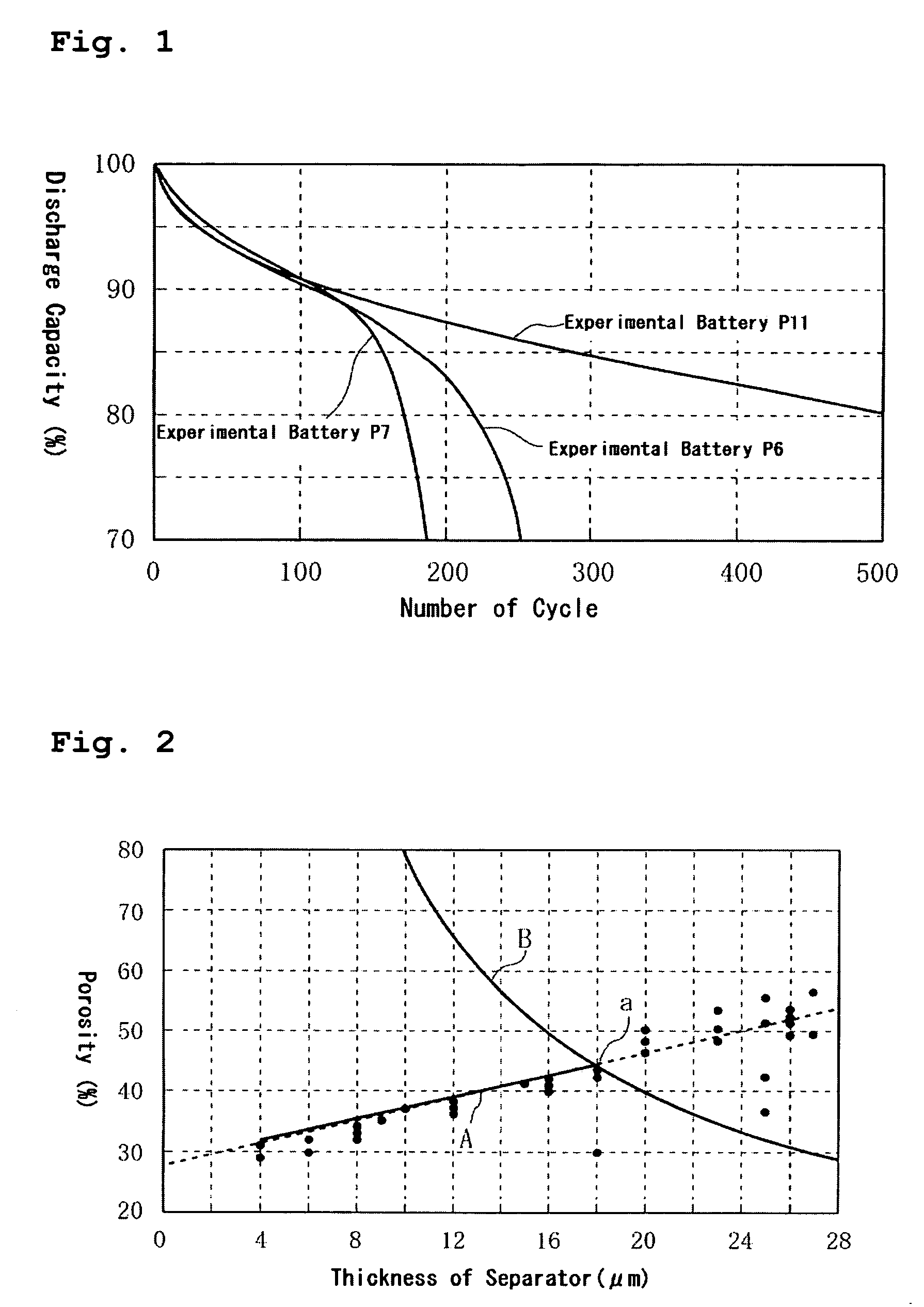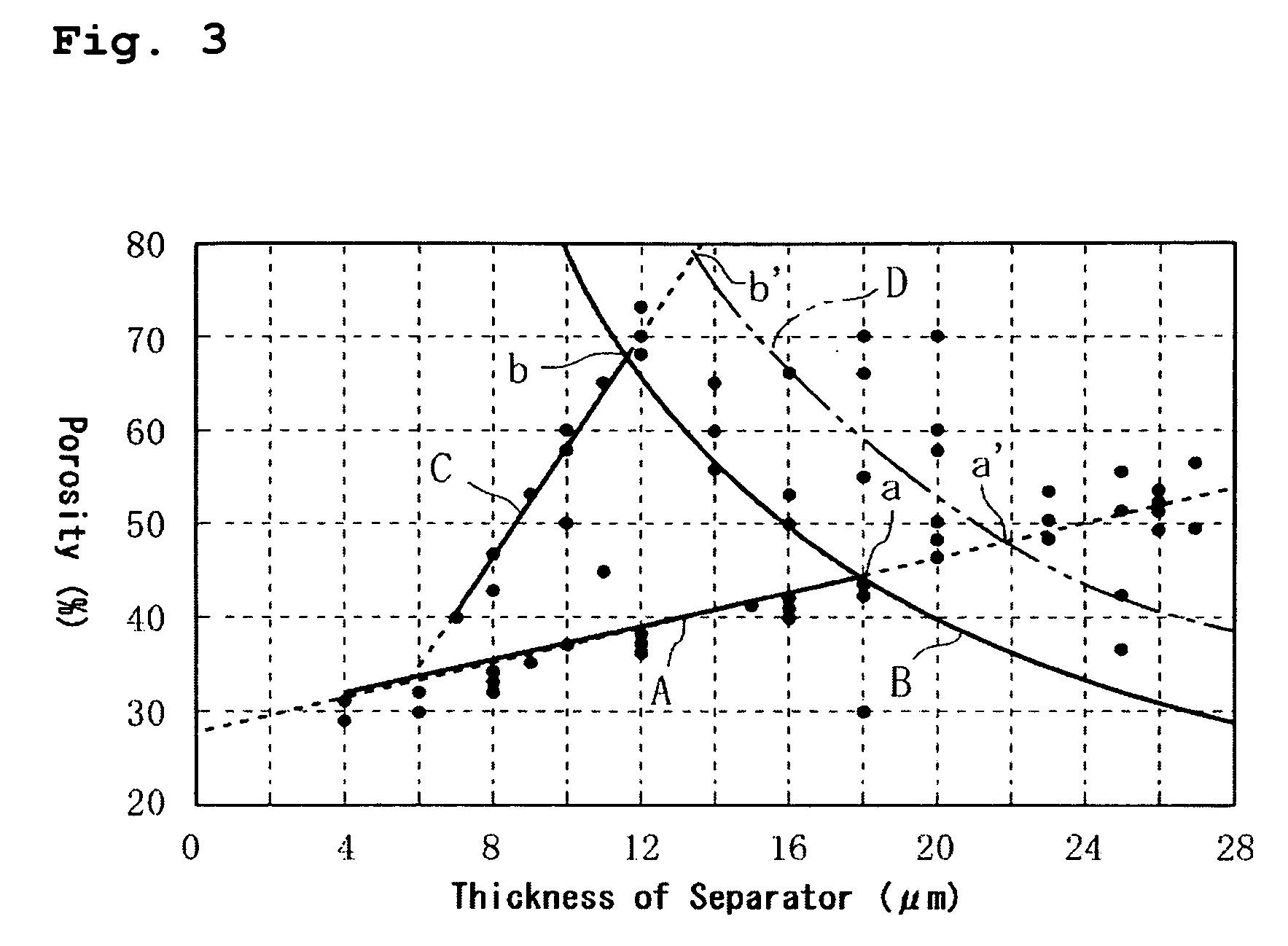Battery separator and non-aqueous electrolyte secondary battery using the separator
- Summary
- Abstract
- Description
- Claims
- Application Information
AI Technical Summary
Benefits of technology
Problems solved by technology
Method used
Image
Examples
examples
Preliminary Experiment
Experimental Batteries 1 to 16
[0065] Batteries were prepared in the same manner as in the foregoing embodiment except that, in each of the batteries, the separator was made of a polyethylene single-layer film and the thickness and porosity of each separator was changed as set forth in Tables 1 to 3 below. The batteries thus prepared are hereinafter referred to as Experimental Batteries P1 to P16.
[0066] It should be noted that the porosity of each of the separators was measured as follows. The same method of the measurement was adopted throughout the following experiments.
Measurement of Separator Porosity
[0067] Each of the films to be used as the separators was cut into a 10 cm×10 cm square, and the mass (W g) and the thickness (D cm) of each sample were measured. The mass of a material within the sample was determined by calculation, then the mass of the material [Wi(i=1 to n)] was divided by the absolute specific gravity, to estimate the volume of the ...
experiment 1
[0068] Experiment 1 examines the relationship between the physical properties (electrolyte accommodating rate) of the separator and cycle life. Specifically, Experimental Batteries P1 to P16 were charged and discharged for 500 cycles under the following charge-discharge conditions (temperature: 25° C.) to examine the cycle life (about whether an electrolyte dry-out occurred and an approximate number of cycles at which cycle life degradation occurred due to the electrolyte dry-out) of each of the batteries. The results are collectively shown in Tables 1 to 3. As for Experimental Batteries P6, P7, and P11, the relationship between number of cycles and discharge capacity was also examined. The results are shown in FIG. 1.
Charge-Discharge Conditions
[0069] Charge Conditions
[0070] Each of the batteries was charged at a constant current of 1C (850 mA) to 4.2 V and charged at a constant voltage 4.2 V to a current of C / 20 (42.5 mA).
[0071] Discharge Test
[0072] Each of the batteries was ...
experiment 2
[0082] Experiment 2 examined the conditions necessary to pass the thermal test for batteries specified by the UL standard. Specifically, in the measurement of thermal contraction of a separator as described in the following, it is desirable that a separator shows a thermal contraction of 20% or lower after the separator has been kept at 120° C. for 10 minutes.
Measurement of Separator Thermal Contraction
[0083] Each of test pieces of separators (5 cm×2 cm) was placed between slide glasses, and both ends of the glasses were fixed with clips. The test pieces were retained for 10 minutes at various temperatures to obtain percentage of shrinkage.
[0084] The results indicated that when the thickness of the separator exceeded 18 μm, the anti-thermal contraction performance can be ensured corresponding to the necessary strength (corresponding to the later-described thermal test) because of the thickness, so the porosity can be relatively freely set even if the separator is formed of a pol...
PUM
| Property | Measurement | Unit |
|---|---|---|
| Temperature | aaaaa | aaaaa |
| Thickness | aaaaa | aaaaa |
| Thickness | aaaaa | aaaaa |
Abstract
Description
Claims
Application Information
 Login to View More
Login to View More - R&D
- Intellectual Property
- Life Sciences
- Materials
- Tech Scout
- Unparalleled Data Quality
- Higher Quality Content
- 60% Fewer Hallucinations
Browse by: Latest US Patents, China's latest patents, Technical Efficacy Thesaurus, Application Domain, Technology Topic, Popular Technical Reports.
© 2025 PatSnap. All rights reserved.Legal|Privacy policy|Modern Slavery Act Transparency Statement|Sitemap|About US| Contact US: help@patsnap.com


